Transformers
Marcos V. Treviso
Instituto de Telecomunicações
December 19, 2019
Refs
Attention is all you need
https://arxiv.org/abs/1706.03762
The illustrated transformer
http://jalammar.github.io/illustrated-transformer/
The annotated transformer
http://nlp.seas.harvard.edu/2018/04/03/attention.html
Łukasz Kaiser’s presentation
https://www.youtube.com/watch?v=rBCqOTEfxvg
A high-level look

Encoder-Decoder
context vector
Encoder
Decoder
↺
↺
BiLSTM
LSTM
$$x_1 \, x_2 \,...\, x_n$$
$$y_1 \, y_2 \,...\, y_m$$
Encoder-Decoder
Encoder
Decoder
BiLSTM
LSTM
$$x_1 \, x_2 \,...\, x_n$$
context vector
$$y_1 \, y_2 \,...\, y_m$$
↺
↺
Attention
query keys values
$$\mathbf{q} \in \mathbb{R}^{ d_q}$$
$$\mathbf{K} \in \mathbb{R}^{n \times d_k}$$
$$\mathbf{V} \in \mathbb{R}^{n \times d_v}$$
Attention
query keys values
$$\mathbf{q} \in \mathbb{R}^{ d_q}$$
$$\mathbf{K} \in \mathbb{R}^{n \times d_k}$$
$$\mathbf{V} \in \mathbb{R}^{n \times d_v}$$
1. Compute a score between q and each kj
$$\mathbf{s} = \mathrm{score}(\mathbf{q}, \mathbf{K}) \in \mathbb{R}^{n} $$
Attention
query keys values
$$\mathbf{q} \in \mathbb{R}^{ d_q}$$
$$\mathbf{K} \in \mathbb{R}^{n \times d_k}$$
$$\mathbf{V} \in \mathbb{R}^{n \times d_v}$$
1. Compute a score between q and each kj
dot-product:
bilinear:
additive:
neural net:
$$\mathbf{k}_j^\top \mathbf{q}, \quad (d_q == d_k)$$
$$\mathbf{k}_j^\top \mathbf{W} \mathbf{q}, \quad \mathbf{W} \in \mathbb{R}^{d_k \times d_q}$$
$$\mathbf{v}^\top \mathrm{tanh}(\mathbf{W}_1 \mathbf{k}_j + \mathbf{W}_2 \mathbf{q})$$
$$\mathrm{MLP}(\mathbf{q}, \mathbf{k}_j); \quad \mathrm{CNN}(\mathbf{q}, \mathbf{K}); \quad ...$$
$$\mathbf{s} = \mathrm{score}(\mathbf{q}, \mathbf{K}) \in \mathbb{R}^{n} $$
Attention
query keys values
$$\mathbf{q} \in \mathbb{R}^{ d_q}$$
$$\mathbf{K} \in \mathbb{R}^{n \times d_k}$$
$$\mathbf{V} \in \mathbb{R}^{n \times d_v}$$
1. Compute a score between q and each kj
$$\mathbf{s} = \mathrm{score}(\mathbf{q}, \mathbf{K}) \in \mathbb{R}^{n} $$
2. Map scores to probabilities
$$\mathbf{p} = \pi(\mathbf{s}) \in \triangle^{n} $$
Attention
query keys values
$$\mathbf{q} \in \mathbb{R}^{ d_q}$$
$$\mathbf{K} \in \mathbb{R}^{n \times d_k}$$
$$\mathbf{V} \in \mathbb{R}^{n \times d_v}$$
1. Compute a score between q and each kj
$$\mathbf{s} = \mathrm{score}(\mathbf{q}, \mathbf{K}) \in \mathbb{R}^{n} $$
2. Map scores to probabilities
$$\mathbf{p} = \pi(\mathbf{s}) \in \triangle^{n} $$
softmax:
sparsemax:
$$ \exp(\mathbf{s}_j) / \sum_k \exp(\mathbf{s}_k) $$
$$ \mathrm{argmin}_{\mathbf{p} \in \triangle^n} \,||\mathbf{p} - \mathbf{s}||_2^2 $$
Attention
query keys values
$$\mathbf{q} \in \mathbb{R}^{ d_q}$$
$$\mathbf{K} \in \mathbb{R}^{n \times d_k}$$
$$\mathbf{V} \in \mathbb{R}^{n \times d_v}$$
1. Compute a score between q and each kj
$$\mathbf{s} = \mathrm{score}(\mathbf{q}, \mathbf{K}) \in \mathbb{R}^{n} $$
2. Map scores to probabilities
$$\mathbf{p} = \pi(\mathbf{s}) \in \triangle^{n} $$
3. Combine values via a weighted sum
$$\mathbf{z} = \sum\limits_{i=1}^{m} \mathbf{p}_i \mathbf{V}_i \in \mathbb{R}^{d_v}$$
Drawbacks of RNNs
- Sequential mechanism prohibits parallelization
- Long-range dependencies are tricky, despite gating
$$x_1$$
$$x_2$$
...
$$x_n$$
$$x_1 \quad x_2 \quad x_3 \quad x_4 \quad x_5 \quad x_6 \quad x_7 \quad x_8 \quad x_9 \quad ... \quad x_{n-1} \quad x_{n}$$
Transformer

Transformer
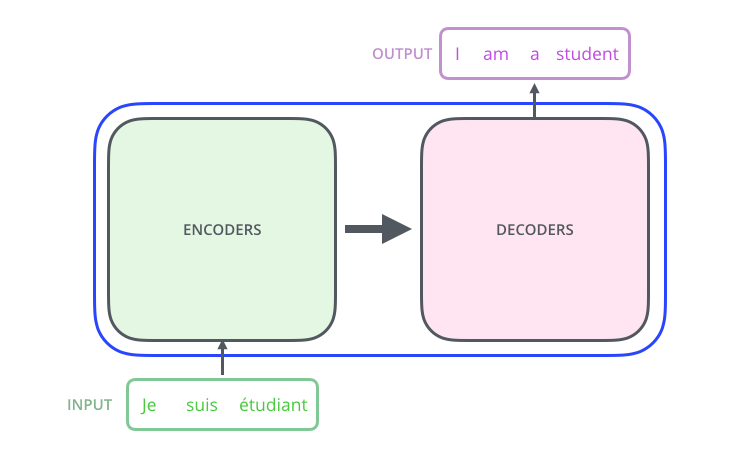
$$x_1 \, x_2 \,...\, x_n$$
$$\mathbf{r}_1 \, \mathbf{r}_2 \,...\, \mathbf{r}_n$$
$$y_1 \, y_2 \,...\, y_m$$
encode
decode
Transformer

Transformer
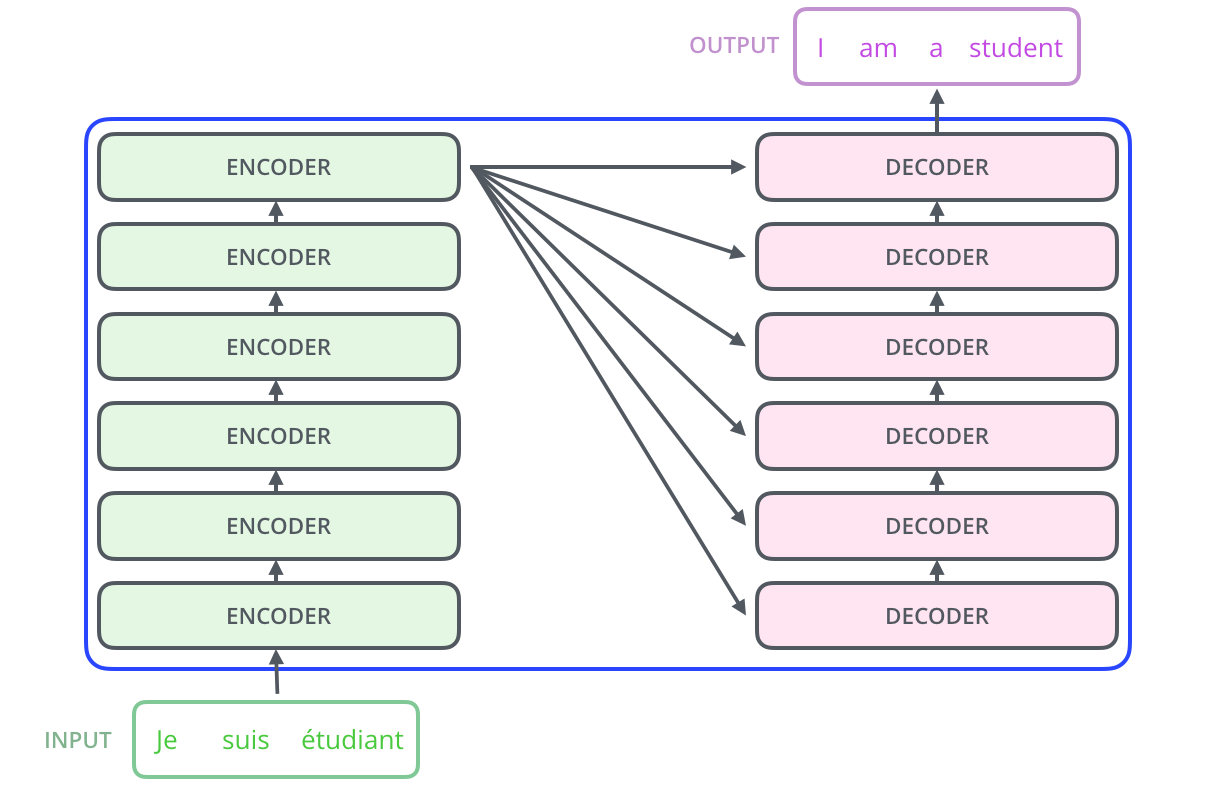
Transformer blocks

The encoder

Self-attention

"The animal didn't cross the street because it was too tired"
Self-attention

"The animal didn't cross the street because it was too tired"
$$\mathbf{Q}_j = \mathbf{K}_j = \mathbf{V}_j \in \mathbb{R}^{d} \quad \iff$$
dot-product scorer!
Transformer self-attention

Transformer self-attention

Transformer self-attention
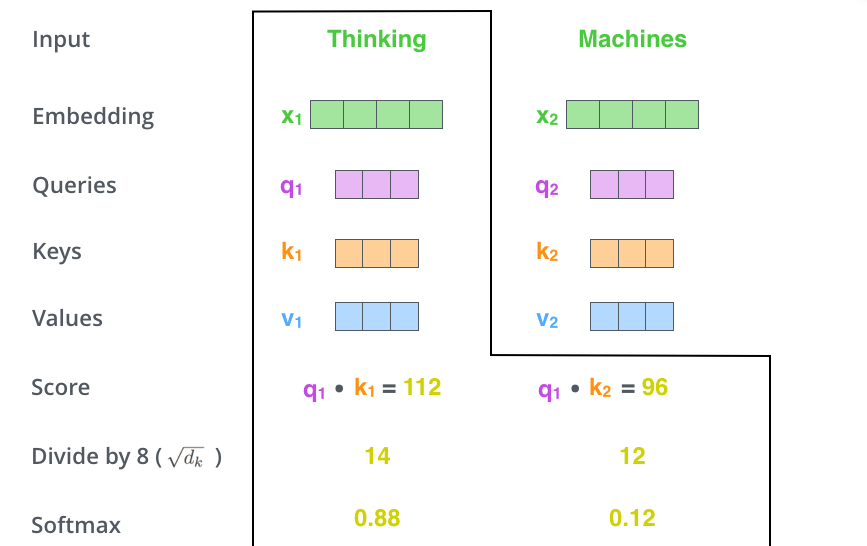
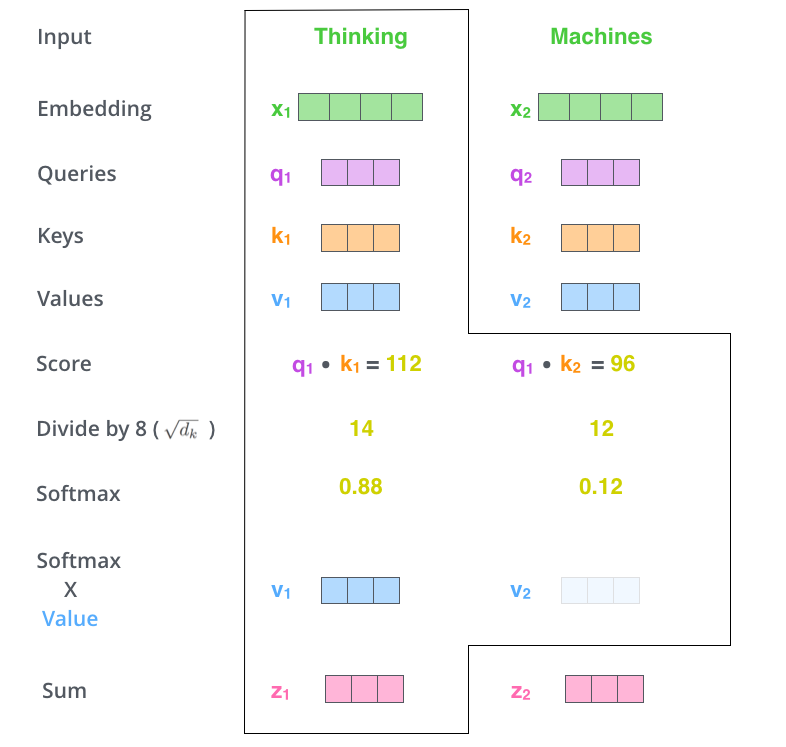
Matrix calculation
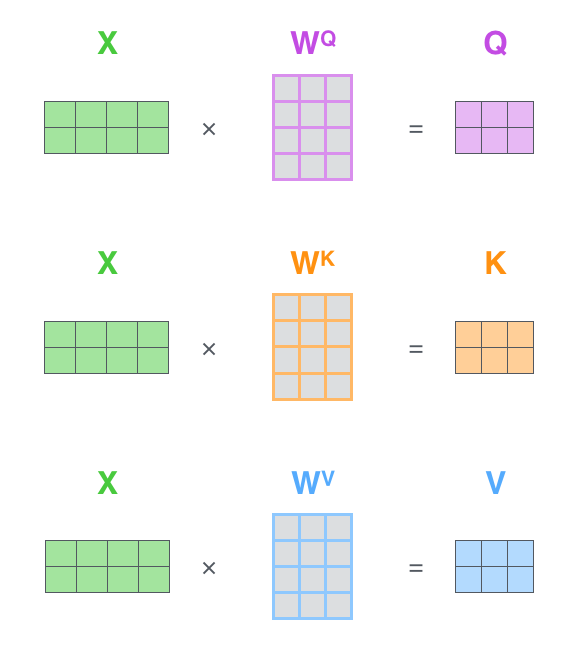
Matrix calculation
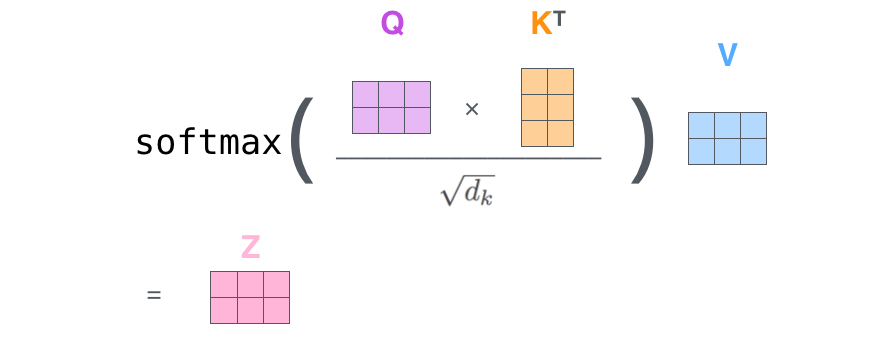
Matrix calculation

$$\mathbf{S} = \mathrm{score}(\mathbf{Q}, \mathbf{K}) \in \mathbb{R}^{n \times n} $$
$$\mathbf{P} = \pi(\mathbf{S}) \in \triangle^{n \times n} $$
$$\mathbf{Z} = \mathbf{P} \mathbf{V} \in \mathbb{R}^{n \times d}$$
$$\mathbf{Z} = \mathrm{softmax}\Big(\frac{\mathbf{Q} \mathbf{K}^\top}{\sqrt{d_k}}\Big) \mathbf{V} $$
$$\mathbf{Q}, \mathbf{K}, \mathbf{V} \in \mathbb{R}^{n \times d}$$
Problem of self-attention

- Convolution: a different linear transformation for each relative position
> Allows you to distinguish what information came from where
- Self-attention: a weighted average :(
Fix: multi-head attention
- Multiple attention layers (heads) in parallel
- Each head uses different linear transformations
- Attention layer with multiple “representation subspaces”

Multi-head attention

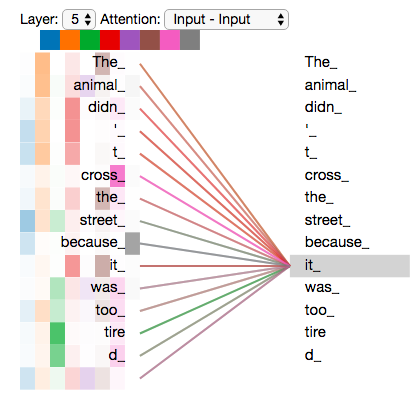
2 heads
all heads (8)
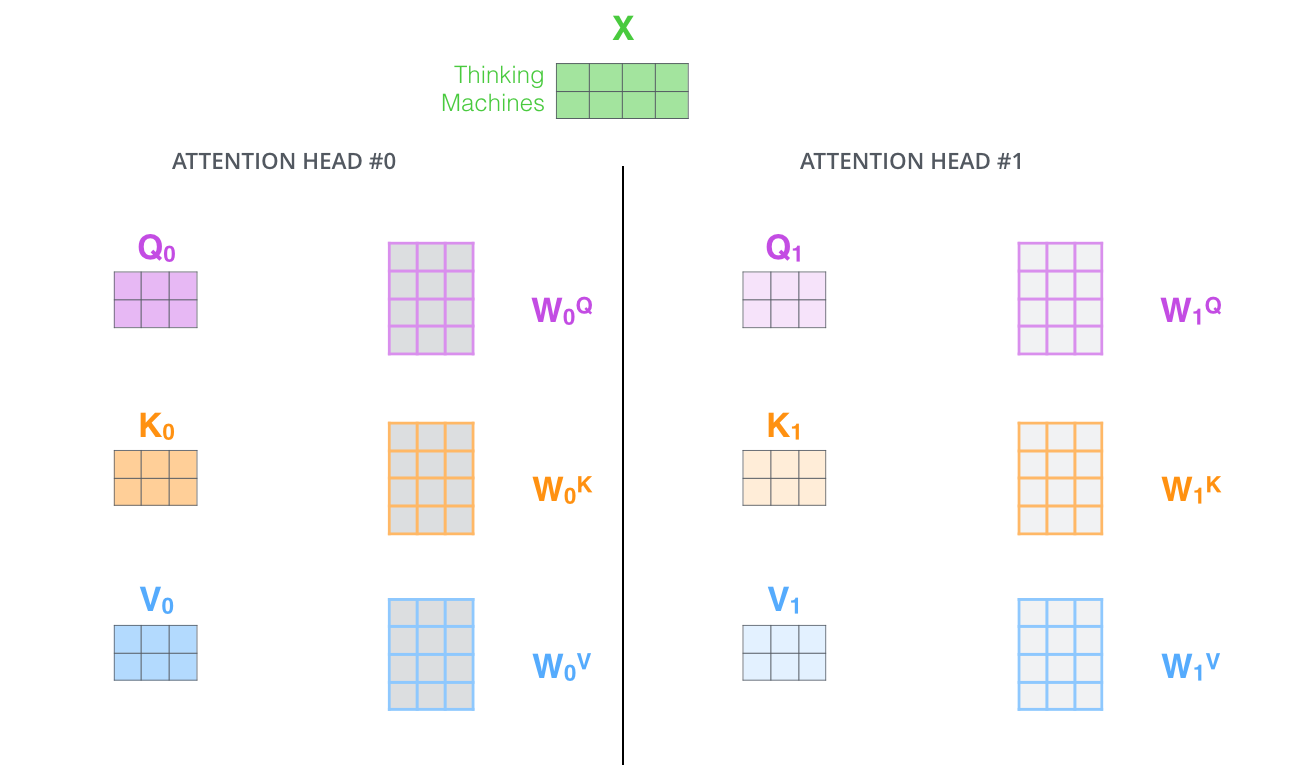
Multi-head attention
Multi-head attention
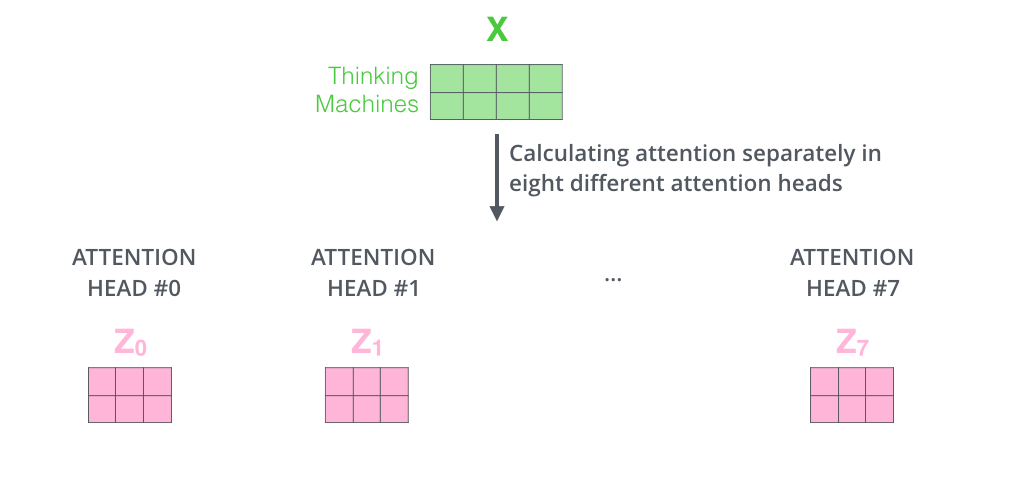
Multi-head attention
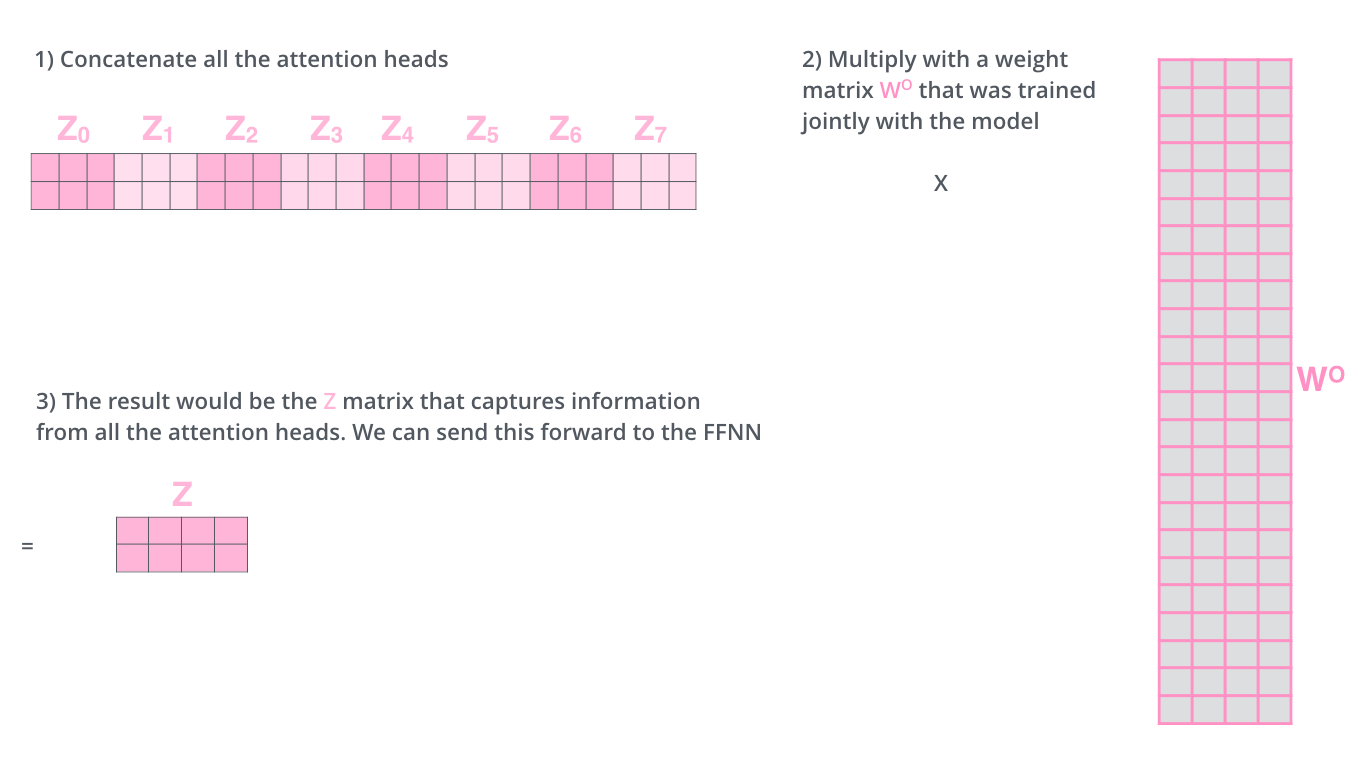
Multi-head attention

Multi-head attention
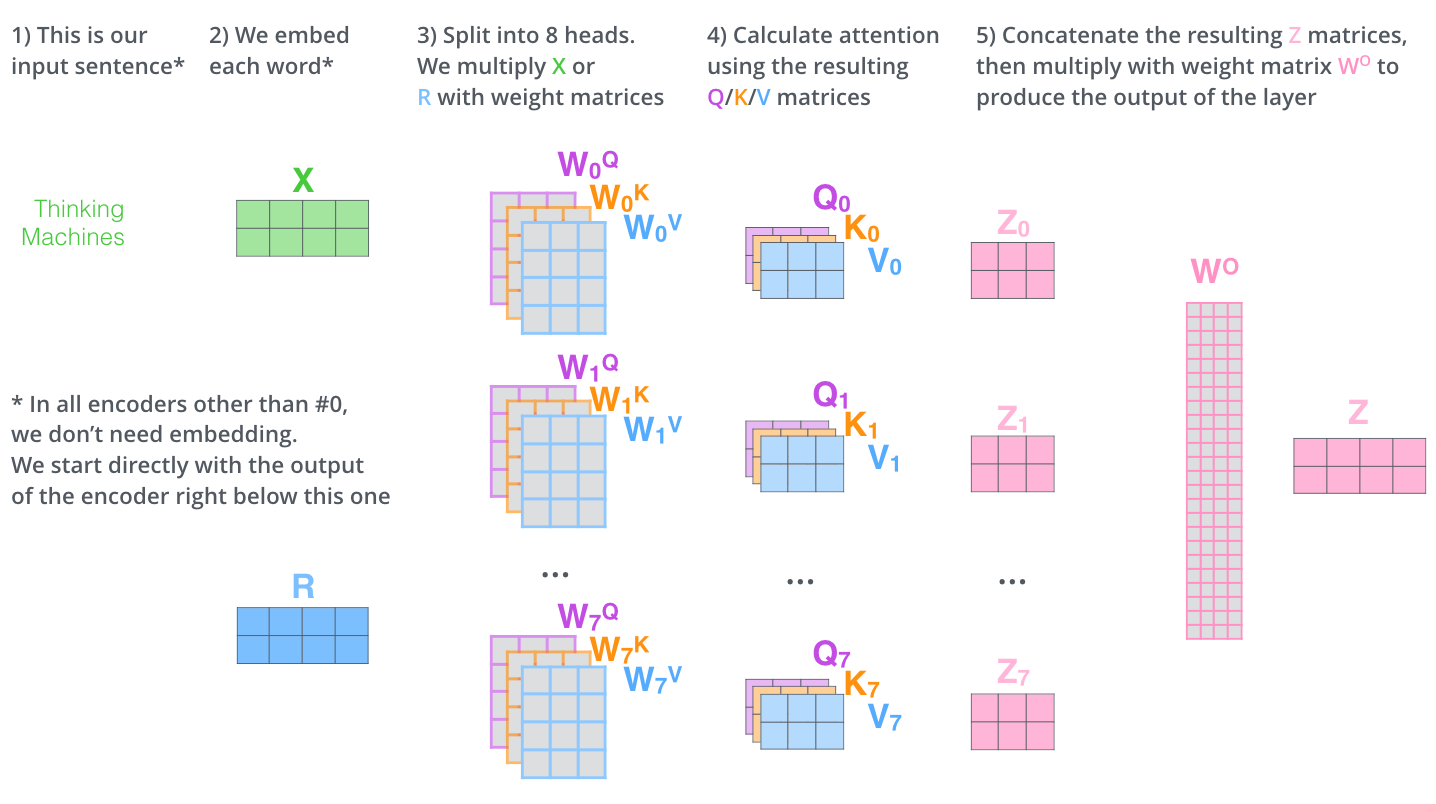
Positional encoding
- A way to account for the order of the words in the seq.

Positional encoding

Positional encoding

Residuals & LayerNorm

Residuals & LayerNorm
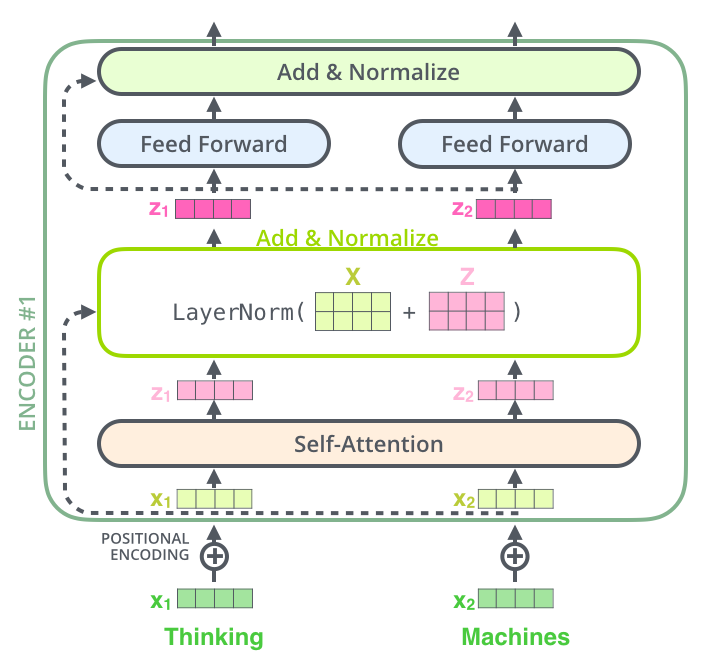
Residuals & LayerNorm
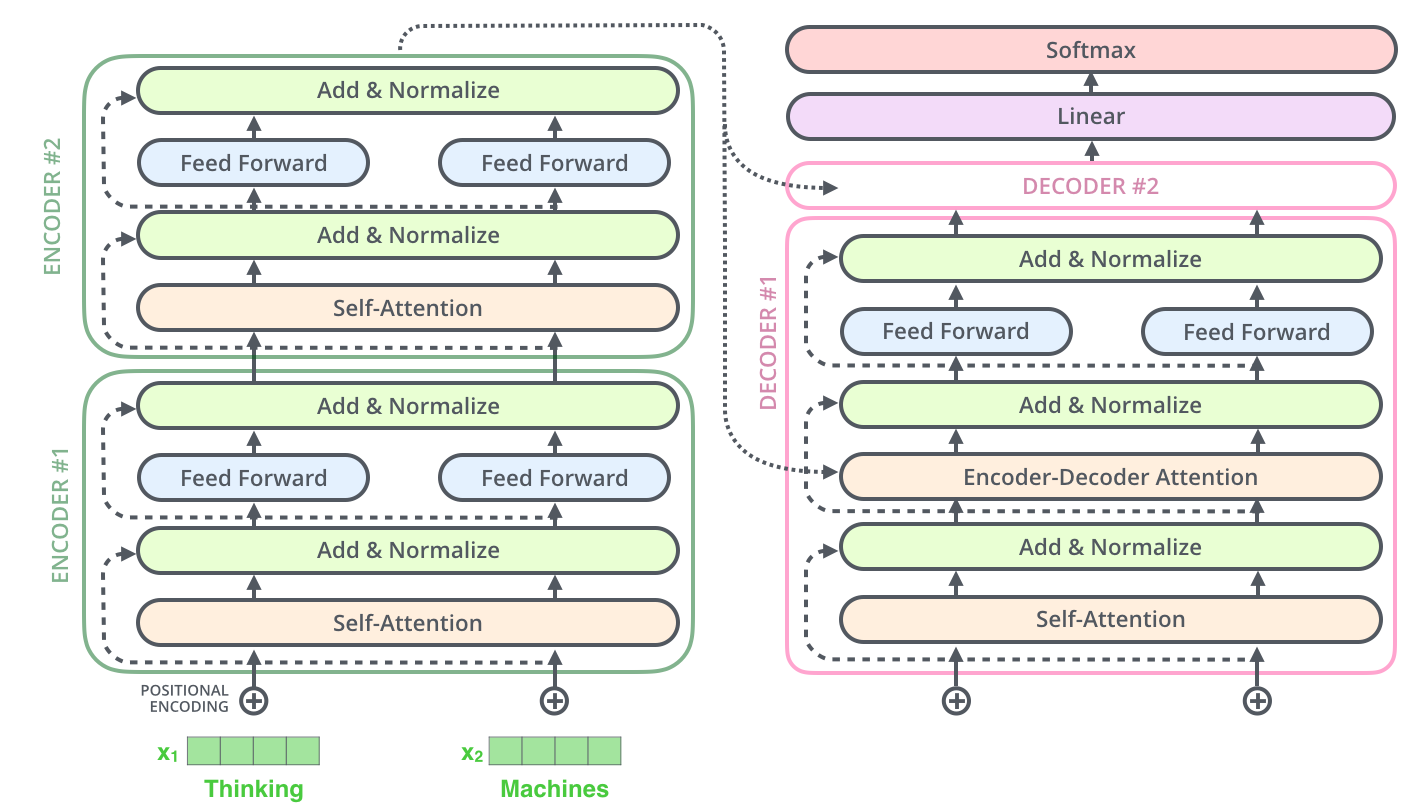
The decoder

encoder self-attn
The decoder


encoder self-attn
The decoder


encoder self-attn
decoder self-attn (masked)

The decoder


encoder self-attn
decoder self-attn (masked)

- Mask subsequent positions (before softmax)
The decoder



encoder self-attn
context attention
decoder self-attn (masked)

The decoder



encoder self-attn
context attention
- Use the encoder output as keys and values
$$\mathbf{S} = \mathrm{score}(\mathbf{Q}, \mathbf{R}_{enc}) \in \mathbb{R}^{m \times n} $$
$$\mathbf{P} = \pi(\mathbf{S}) \in \triangle^{m \times n} $$
$$\mathbf{Z} = \mathbf{P} \mathbf{R}_{enc} \in \mathbb{R}^{m \times d}$$
decoder self-attn (masked)
$$\mathbf{R}_{enc} = \mathrm{Encoder}(\mathbf{x}) \in \mathbb{R}^{n \times d} $$
The decoder
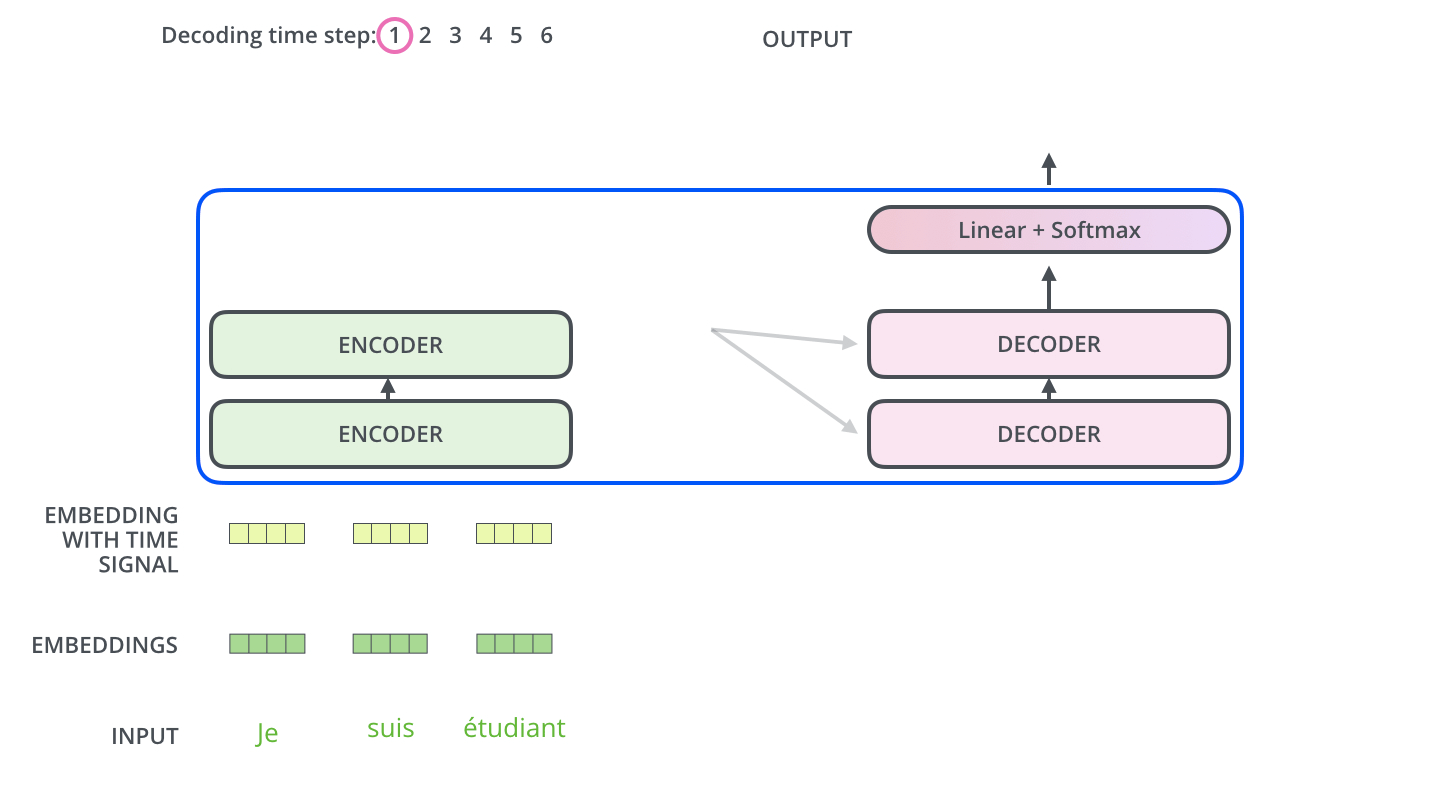
The decoder
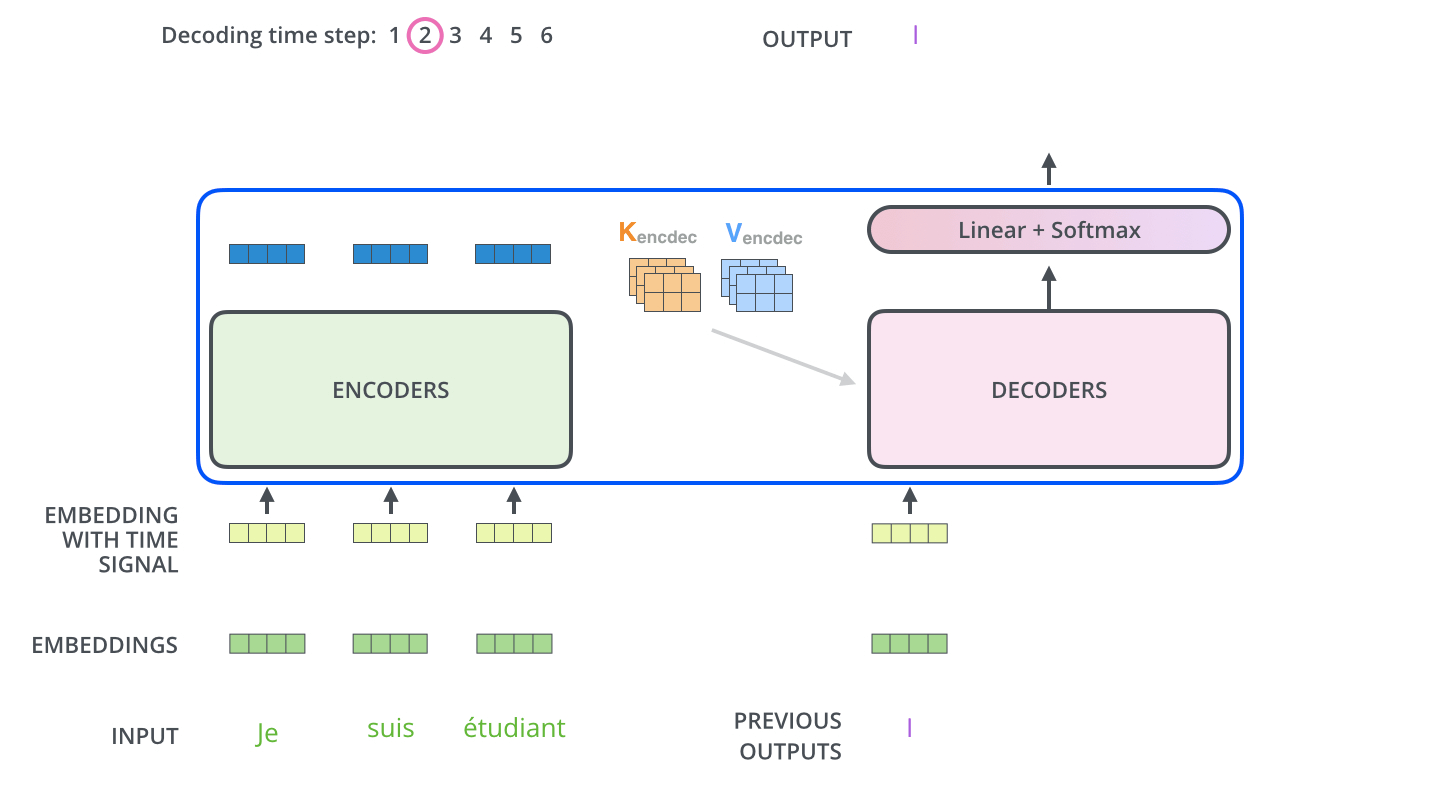
Computational cost

n = seq. length d = hidden dim k = kernel size
Other tricks
- Training Transformers is like black-magic. In the original paper they employed a lot of other tricks:
- Label smoothing
- Dropout at every layer before residuals
- Beam search with length penalties
- Subword units - BPEs
- Adam optimizer with learning-rate decay
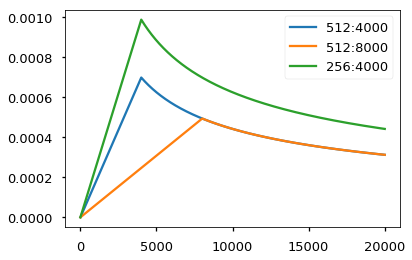
Coding & training tips
- Sasha Rush's post is a really good start point:
http://nlp.seas.harvard.edu/2018/04/03/attention.html
- OpenNMT-py implementation:
encoder part | decoder part
on the "good" order of LayerNorm and Residuals
- PyTorch has a built-in implementation since August
torch.nn.Transformer
- Training Tips for the Transformer Model
https://arxiv.org/pdf/1804.00247
What else?
- BERT uses only the encoder side; GPT-2 uses only the decoder side
- Absolute vs relative positional encoding
https://www.aclweb.org/anthology/N18-2074.pdf
- Transformer-XL: keep a memory of previous encoded states
http://arxiv.org/abs/1901.02860
- Sparse transformers
https://www.aclweb.org/anthology/D19-1223.pdf